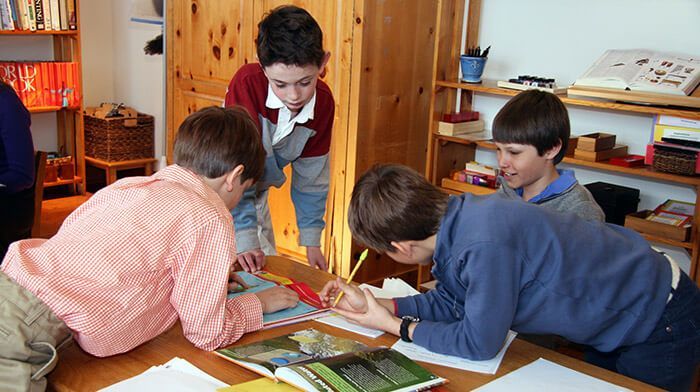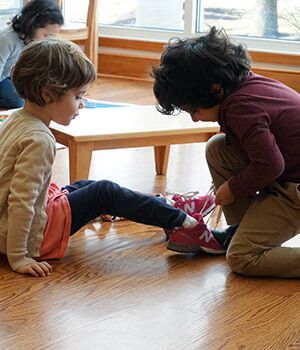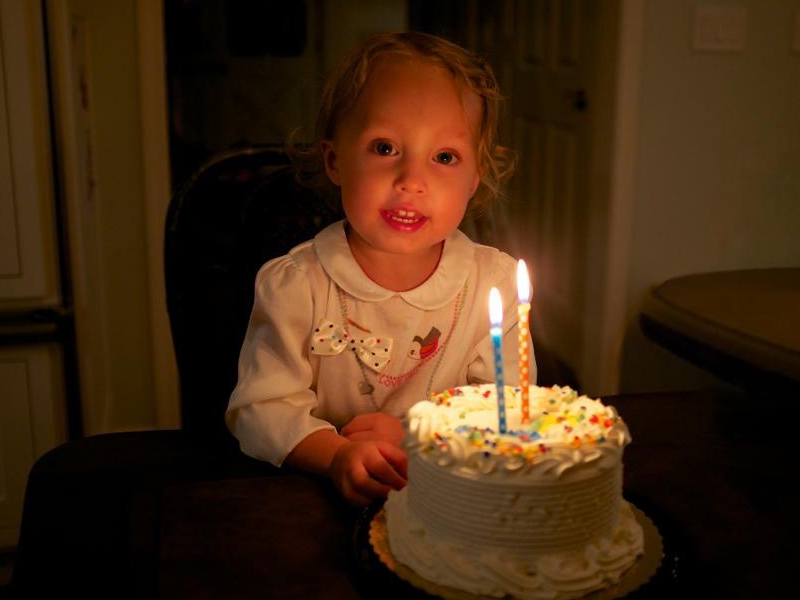
I have been asked, how do we help our children develop moral values in a Montessori setting?
I will start with an anecdote: Last week, I got goose bumps and my eyes welled up with tears as I witnessed the entire student body at Forest Bluff enter the school hallway, arrange themselves in complete silence to sit facing the front, and join their voices to sing traditional Christmas carols. Our Jewish, Muslim, Hindu, atheist, and Christian children enjoy sharing the pleasure of this school tradition, respecting one another’s religions and seeing what they all have in common when seeking peace through communication and mutual respect.
The most astonishing part of this annual school tradition is the self-control that each child demonstrates by choice, from the smallest 18 month old to the tallest 14 year old. What I realized this year is that these children—all of these Montessori children—truly know what it means to be individuals forming a community. They understand that it takes the participation of each and every one of them to create the total silence and to sing in unison, then to rise carefully and return to their classrooms. It gives one great hope for the future and shows that we are helping these children are develop moral values to work with others.
Children Need to Develop Moral Values
Maria Montessori was no stranger to violence and persecution; she lived through both World Wars, saw Mussolini, Stalin and Hitler come to power, and witnessed terrible acts of genocide. She was exiled from her own country, and her schools were shut down because they promoted freedom of thought. Montessori did act, however: she designed an educational approach that she called an “education for peace,” designed in every aspect to help children learn to empathize, work with each other, and build their own morals from within.
She saw that our children do not learn morals from being lectured to, subjected to rewards and punishments, or told to compete against their fellows. She pointed out, “We take for granted that children can be enlightened by the word and that, if they so desire, can live our advice. Instead, my method of education approaches this differently…. They are beings having within them forces which must develop of themselves, over which I have no power, and whose development I can only assist.” She believed that we must work with what she identified as an inner sensitivity that young children have to what feels good or what feels bad. It is the development of this “gut feeling” that makes a child pursue one action over another and to restrain him or herself from doing an undesirable action and that we must nurture. This natural inner urge will help our children develop moral values.
Montessori’s Unique Approach to Helping Children Develop Moral Values

You may have heard us explain that Montessori is most effective because it matches the educational approach with each stage of children’s development. Children develop through distinct, recognizable stages, or “planes of development,” no matter where they are born, how intelligent they are, or what their experiences are. When we can deliver information in ways that appeal to the characteristics of the stage or plane a child is in, we can make a real impact.
Between ages zero to six, young children absorb information about the world through their senses. This is also how very young children develop moral values; they will pick up what they see modeled and from the environment they are exposed to. At school, we help young children develop moral values through Grace and Courtesy lessons, the ultimate one being the “silence game.” The feeling of good and bad, right and wrong, is swelling inside them but has not been given a name, is not understood with the intellect or reason; it is innate, absorbed without judgment. As parents, this is the time to save your words and moral lessons and demonstrate with your own actions and expose them to the best. This is the best way to help young children develop moral values—they will internalize what they witness. This then becomes their “gut feeling.”
Between ages six and twelve, children go through a long trial-and-error stage, where they test the morals they have been forming in themselves during their early years. Elementary children collect information through experimenting, developing their ability to verbally reason through right and wrong, and making choices. They seem to need to make a lot of mistakes! They will steal, lie, cheat, be mean to friends, use swear words, say inappropriate or offensive things—sometimes even the sweetest of children do these things. It can be awful for us parents to watch this experimenting.
However, the consequences for their undesirable actions are built in, because, in a Montessori classroom, misbehaving children experience their classmates’ negative reactions, feel shame and embarrassment and an unpleasant “gut feeling.” These inner feelings guide them to change their behavior. By design, the children need partners to do certain work and community exercises, so they have to figure out how to work with one other. The environment is one of community, so everyone figures out how to work out their issues and synergize. Through this very natural approach Montessori elementary children develop moral values.
Because six to twelve year olds are more nimble than adults are, children can change rapidly at these ages: a child tries something different and gets good feedback and good feelings only moments of behaving negatively. Again the next day, he may find himself—or herself—doing something mean or disreputable, like stealing rubber bands, breaking paper clips, starting a rumor about a friend and snickering, and those unpleasant feelings swell inside, providing nature’s guide.
Of course, a teacher may interfere as needed, perhaps by moving a disruptive child so that others can continue in their work or taking away a child’s freedoms for a short period of time, but truly, the “punishment” is the natural consequence from the community and that inner feeling that guides. Some children need to experiment more than others, but observing the behavior and popularity of others, feeling the desire to belong, to feel closeness with others, does much of the correcting.
As parents and teachers, we can work with the Elementary children’s new ability to reason and imagine how others may feel or what the outcome of different behaviors might be. These children love to talk about moral issues and explore them through fantastical worlds and historical stories, fables and myths. Reading classic literature and having discussions about what the children notice in the characters is one way we can nurture their moral development in this stage. Reading about and exploring desirable and undesirable behaviors, as in Tom Sawyer, Anne of Green Gables, Black Beauty, or Harriet the Spy, provides wonderful opportunities to talk about what you and your children notice. But even if they are very quiet about their thoughts, you are providing your Elementary children with great material to ponder by reading these classics with them.
By ages 12 to 14, the experimenting phase ends and a sensitive individual who needs to be in a small, trusted, close community emerges. Our Secondary Level students develop moral values as they work together, almost like their own tribe, to serve others outside our community. They travel into the wilderness with only one another to depend on, survive the elements, build structures for other communities, and leave a lasting mark when they leave. They experience, again and again, the results of their positive work, and they develop a pride and confidence in one another and themselves. They graduate from Forest Bluff School at age 14 with a wealth of knowledge about themselves and about getting along with a variety of other people. Even though we are a small school, our students are very different from one another in numerous ways and because Montessori celebrates individuality in all subjects, the children realize how different they each are and what it entails to create a healthy community.

With adolescents, we again return to modeling adult behavior—talk less, act more—as we did with the youngest children. Now our children will see past the surface as they are learning about all the gray areas in life. They will see our adult flaws as well as our strengths. Adolescents are in the stage of developing the ability to see the world more clearly and understand its increasing complexity. This is when discussing politics and moral dilemmas helps adolescents voice their own opinions and find their own voices as they enter the adult world. They will change their minds many times and must not be forced, ridiculed, or shamed, but be permitted to try out their verbal rhetoric and investigate the wide range of ideas human history presents to us.
Supporting Children as They Develop Moral Values at Home
In all of their developmental stages, we cannot force our children to develop moral values by using a stagnant model of rewards and punishments. Montessori cautioned us to have no illusions of power over another human being. She pointed out that nature provides a force we can work with: humans have within them an inner force for good, a desire to be with others and feel good. Thus, our goal as adults must be to nurture and foster this tendency towards goodness and this inner guide. We can:
- expose our very young children to desirable environments
- model our morals in their presence
- share our stories and talk about our beliefs and experiences as our children age
- explore the intellectual ideas of humanity with our adolescents
- and
allow
natural consequences to cultivate an inner guide
“Have faith in the Child,” Montessori told us. It takes many years to develop morality, and we have to support our children with a kind of faith. When we doubt, we need only think of those children in our school’s hallway under the cathedral-like ceiling, showing their desire to create something great. They can do it.


